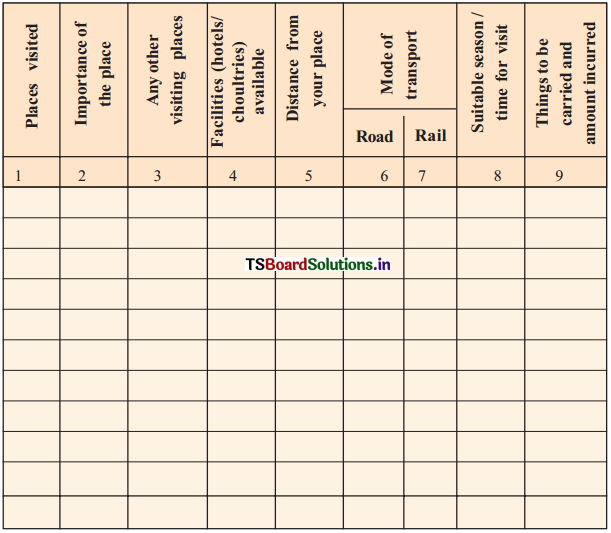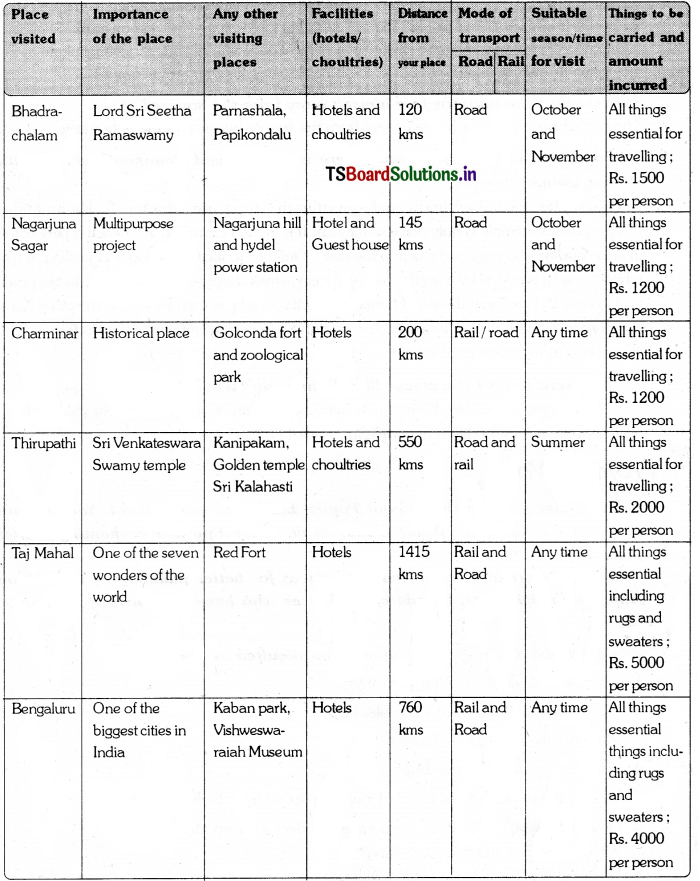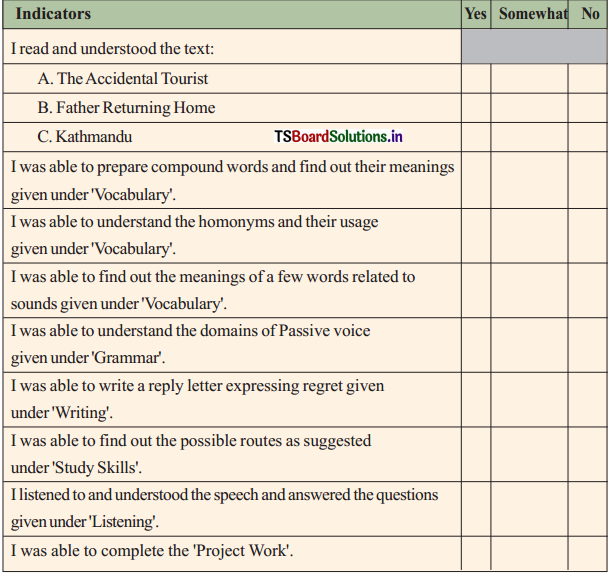TS Board Telangana SCERT Class 9 English Solutions Unit 8C Kathmandu Textbook Questions and Answers.
TS 9th Class English Guide Unit 8C Kathmandu
Questions and Answers:
Answer the following questions.
Question 1.
What is the belief at Pashupathinath temple about the end of Kaliyuga ?
Answer:
A small shrine half protrudes from the stone platform on the river bank. When it emerges fully, the goddess inside will escape, and the evil period of the Kaliyuga will end on earth. She loves flute music. It is at once the most universal and most particular of sounds. Every culture in the world has its own style of flute music. Each has its own fingering and compass.
Question 2.
Why couldn’t the narrator tear himself away from the square?
Answer:
The narrator couldn’t tear himself away from the square because of the flute music.
![]()
Question 3.
Compare and contrast the atmosphere in and around Baudhnath shrine with Pashupathinath temple.
Answer:
Both temples Pashupathinath and Baudhnath Stupa are situated in Kathmandu. Pashupathinath temple is holy place of Hindus. It is always crowded. The worshippers come in large numbers to pray and worship the deity. One has to face elbowing and jostling. It has white dome. It is ringed by a road. There are many small shops selling felt bags Tibetan prints and jewellery. The Great throng of public makes it special place on earth. On the other hand Baudhnath Stupa is very calm place. It is one of the important shrines of the Buddhists. The place presents a serene atmosphere.
Question 4.
Do you want to visit the places like Kathmandu? Why?
Answer:
I like to visit the places like Kathmandu because they are religious and holy places. They represent the culture of different people, in the world.
Project Work:
Imagine that you are the School Pupils’ Leader of your school. Your school authorities asked you to plan a tour to an interesting and enchanting tourist place.
Collect information about various places for better planning by interacting with your neighbours, friends and relatives who have been to various tourist places.
I. Prepare questions to get the information required as above.
- Which places would you like to visit?
- What is the importance of those places?
- What are the other places close to them?
- 4. What are the facilities available there?
- What is the distance from here? / How long is that from here?
- How can we go? / What are the possible modes of transportation?
- Which season is suitable for visiting?
- What are the things to be carried with us?
- How much money do we have to spend?
- Which agencies are to be contacted for making arrangements for the tour?
- Where do we have to stay?
- Who will make arrangements for food and accommodation?
![]()
Collect the data in the following given table.

Answer:

![]()
II. Analyse the data furnished in the table and present it before the class.
Write about the best place you propose to visit and also speak to your team about the merits of the place.
Answer:
Taj Mahal is one of the Seven Wonders of the World. It is regarded as the finest example of Mughal architecture. It is a style of construction which combines the elements from Islamic, Persian, Ottoman, Turkish and Indian architectural styles.
The most outstanding monument built by Emperor Shahjahan is the Taj Mahal at Agra. It is on the bank of River Yamuna. This grand mausoleum was built in memory of his beloved Queen Mumtaj Mahal. It has beep described as “a dream in marble designed by fairies and completed by jewellers.” It is surrounded by beautiful gardens and fountains.
It is made of pure white marble. As a monument of love “it is unsurpassed in the world.”
It stands on a platform of 8.5 meters high. The mausoleum rises to a height of 32.4 meters. It is surmounted by cupolas at each corner. The bulbous dome in the centre of the cupolas has the appearance of an inverted lotus.
There are four smaller domes at the four corners of the building. Four minarets stand at each comer of the terrace. The outer walls and the interior walls are richly decorated with exquisite inlay work and calligraphy.
It is indeed a memorable event in the life of anyone to visit this wonderful place.
![]()
Self Assessment:
How well have I understood this unit?
Read and tick (✓) in the appropriate box.

![]()
Kathmandu Summary in English
Kathmandu is an extract from a delightful travelogue ‘From Heaven Lake’ written by one of the most famous Indian writers in English, Vikram Seth. He has won the Thomas Cook Travel Book Award. Seth has given a vivid picture of the people of Kathmandu and their customs and traditions.
Vikram Seth visits Pashupathinath temple and Baudhnath stupa in Kathmandu. They are the most sacred temples for the Hindus and the Buddhists.
Pashupathinath temple is a crowded temple. Only the Hindus are permitted to enter the temple. Priests, hawkers, devotees, tourists, cows, monkeys, pigeons and dogs roam through the grounds. There is elbowing and jostling to get the attention of the priest in the temple. They show a lot of respect for the royal family of Nepal.
Seth visits the Baudhnath stupa, the Buddhist shrine of Kathmandu. There is a sense of stillness. There are small shops on the outer edge of the road around the white dome of the stupa. It is a place of quietness.
Kathmandu is a religious as well as a business centre. There are narrow and busy streets with shrines and fruit sellers, flute sellers, hawkers of postcards, shops selling western cosmetics, film rolls and chocolate, copper utensils and Nepalese antiques. A number of variety things are available. Though he wanted to travel by bus and train to visit many places like Patna, Benaras, Agra and Delhi he decided to go by flight because he was tired.
Vikram Seth particularly likes the flute and the flute music. He was totally immersed in flute music. He says that every culture has flute music. Each flute has its specific fingering and compass. It weaves its own associations. There is a commonality of all mankind. Flute music is closest to the human voice because its motive force is living breath.
![]()
About the Author:
Vikram Seth is an Indian poet, novelist, travel writer, librettist, childrens writer, biographer and memoirist. He won the WH Smith Literary Award and the Commonwealth Writers Prize for his novel, A Suitable Boy. His travelogue “From Heaven Lake: Travels Through Sinkiang and Tibet’’ won the Thomas Cook Travel Book Award. It was his first popular suc¬cess. It offers insight to Seth as a person, who is candid about the reality and effect of living abroad.
Glossary:
febrile (adj) : having or showing a great deal of nervous excitement
mercenaw (adj) : interested only in the amount of money that you can get from a situation
antique (n) : a decorative object or piece of furniture that is valuable because of its age
blare (v) : sound loudly and harshly
low (v) : (of a cow) moo
marzipan (n) : a sweet yellowish paste of ground almonds, sugar, and egg whites, used to coat large cakes or to make sweets.
brazier (n) : a portable heater consisting of a pan or stand holding lighted coals
nauseating (adj) : making you feel as if you are going to vomit
propel (v) : drive or push forwards
per se (adv) : by or of itself
offhanded (adj) : casual; not showing much interest in something.
enterprise (n) : a business or company.
breathy (adj) : (of a voice) having an audible sound of breathing
compass (n) : range or scope